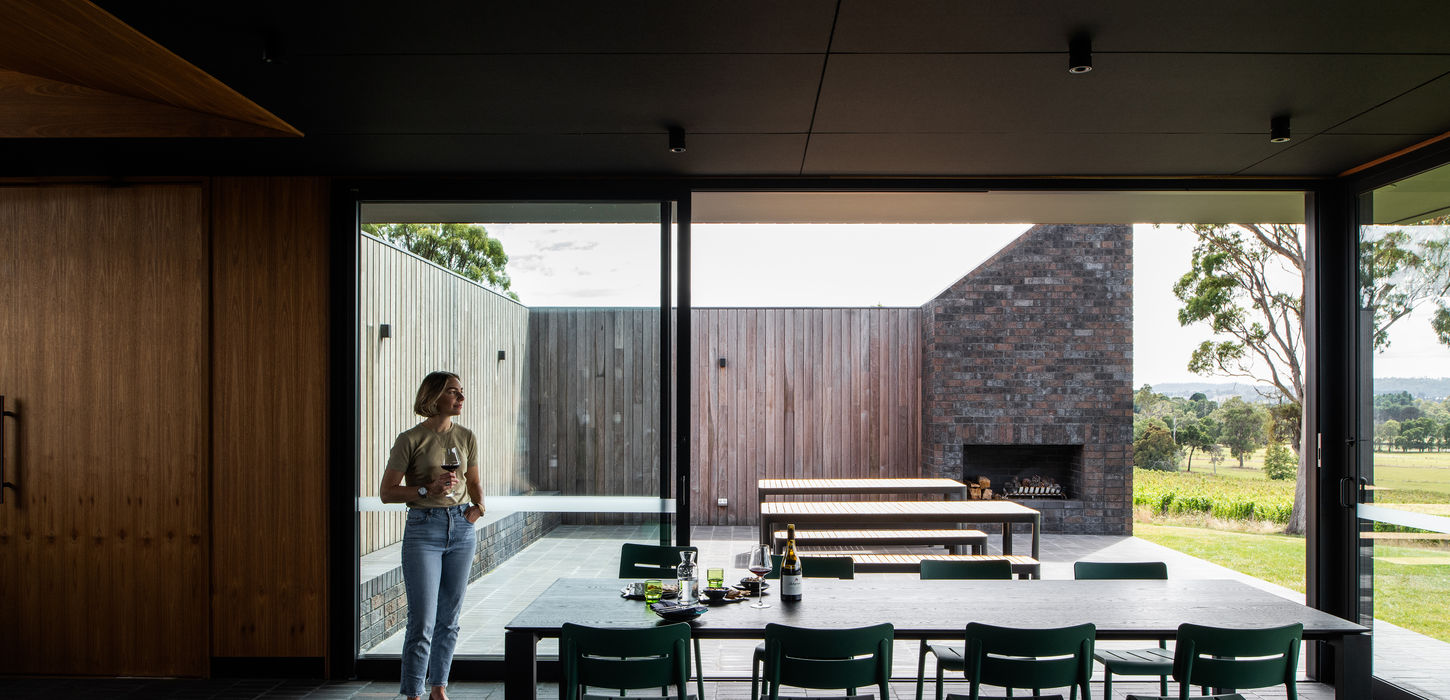A little more conversation.
Stoney Rise Cellar Door makes more from less. We found flexibility within a small, exposed footprint. The material palette is minimal, yet rich. And built sustainably, we reduced the environmental impact, too.
Of course, some aspects weren’t limited at all. The views, for example. On palawa land, Stoney Rise looks beyond grape vines to Tasmania’s Kanamaluka/Tamar River beyond. Our clients, Lou and Joe Holyman, wanted to separate the cellar door from their family residence, and create an adaptable space to suit wine tastings, dinners and different kinds of gatherings.
A smaller budget didn’t deter us from designing with legacy in mind. We spent wisely on quality, enduring materials to minimise both long-term cost and environmental impact. And, just like a fine wine, we carefully chose materials that would only improve with age.
CLIENT
Stoney Rise Wine Company
IMAGES
Anjie Blair
LAND OF
kanamaluka
COLLABORATORS
Eustace Builders
A2 Kitchens & Joinery
Green Building Surveying
JMG Engineers
Rare Innovation
JD Consulting
AWARDS
2022 Architizer A+ Awards, Architecture + Brick - Finalist
2022 Architizer A+ Awards, Bars & Wineries - Finalist
2021 Tasmanian Architecture Awards, Commercial Architecture
2021 Eat Drink Design Awards, Best Retail Space - Shortlisted

Even with a small footprint, there are plenty of different spaces within Stoney Rise. Balancing indoor-outdoor space and a sunny spot out of the wind was an important part of our design. Brick edges, plinths and an outdoor fireplace offer space to gather around. Our cellar door design prompts you to stay a little longer and have another glass on the grass, or hang your legs on the edge of the terrace.
We also fitted a commercial kitchen to allow Stoney Rise to adapt into a pop-up restaurant by night. Though stocked with only the bare essentials, the kitchen allows Stoney Rise to host evenings with celebrated chefs.
Small footprint flexibility.
Material richness, minimal palette.
Flashes of colour offer an understated nod to red and white grapes. As you first enter the cellar door, a burgundy steel door handle hints at the experience beyond. Then, ‘Black Cockatoo’ paint in the bathrooms turns from black to shades of deep green depending on the light. Other simple gestures, like elegantly protruding brickwork ledges, bring your attention to the wine, too.
We grounded the building into the landscape with a rich brick base in tones that nod to Stoney Rise wines. A local brick manufacturer made the bricks for the walls, each of which was rated carbon neutral for sustainability. Thanks to the brick’s thermal mass, the space is naturally heated and cooled without the need for a central system.
A strong collaborative relationship between client, Cumulus, builder, joiner and bricklayers shows in the material detailing. By prioritising locally-sourced, natural, long-lasting materials, the design has the same integrity as the Stoney Rise brand.
As you approach Stoney Rise, the building unfolds. Operating in the round, it welcomes you with different faces to the landscape, depending on your perspective. The site is notoriously windy, so as you enter the building, you’re sheltered and enveloped by protective timber, tucking you away from the views. It’s only as you enter the cellar door that the landscape is revealed again. Emphasised by dark recessive framing, you see eastern views of kanamaluka, and western views of Trousseau grapes.
From the absence of a blackboard to an acoustic panelled ceiling, our design encourages conversation. A big, strategically placed conversation counter allows groups to gather and chat to the vineyard owners as they first enter, and enables the cellar door to operate with minimal staff members for most of the year.
Faces. Landscape.





